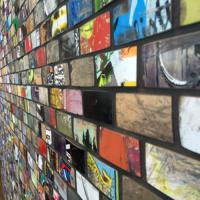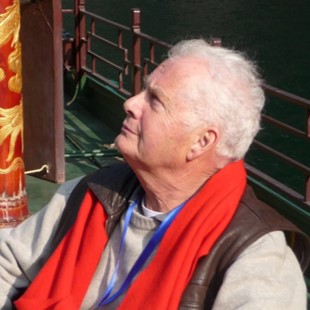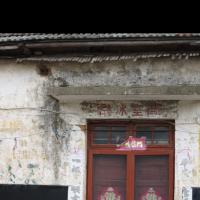An image I found on the Internet inspired me to write my new novel, “Song of the Daisies.” The artist who created the image is Tian Taiquan, whose best known themes are “Lost” and “Totem Recollection,” about the Red Guards during the Cultural Revolution. If you Google him, you’ll see many of his works.
This year is the 50th anniversary of the start of the Cultural Revolution which lasted from 1966 to 1976. Though I didn’t experience this devastating political movement directly, I’ve been interested in it and its impact on today’s China and Chinese people since high school. I suppose that was why I chose Chinese Literature and Language as my college major, despite that I was smitten with Western literature at that time–I wanted to learn more about the so-called “scar literature” or “wound literature” (Shanghen wen xue 伤痕文学), and “search-for-roots literature”(xungeng wen due 寻根文学).
I belong to a post-Cultural Revolution generation, and none of my four older brothers were old enough to be Red Guards during the Cultural Revolution. Yet Tian Taiquan’s art touches me in a very personal way and reminds me of my days as a naive and passionate teenager, as someone with many dreams and questions.
Some of Tian’s most controversial art, (his most impressive in my opinion) are those of the Red Guards who died during the 1966-1968 Chongqing Riot, victims of politics, of their times, and of their unbridled yet distorted love and passion.
“Song of the Daisies” is about the historical and psychological impact of a tumultuous past on ordinary people. Yes, we all say the past is the past, let’s move on, yet we all know that the past is in our blood, in our heartbeat, in the air we breathe.
For my generation growing up in the “Reform and Opening Up” China, our most urgent issue is not how to survive in deprivation and despair, but how to escape the shadow that seems to loom perpetually in the near distance.
To understand today’s China, the economic boom, the corruption, the urbanization, the guanerdai/fuerdai (second generation of government officials and the rich 官二代/富二代) phenomenon, the mingongchao (tidal wave of migrant laborers 民工潮), the rising nationalism, the growing conflicts between the haves and have-nots, and many other social and cultural matters, you must look back at what China has gone through in the past few decades and further beyond.
The New York Times’s Chris Buckley has written about the cemetery that often appears in Tian Taiquan’s art. http://www.nytimes.com/2016/04/05/world/asia/china-cultural-revolution-chongqing.html
As he puts it, “…the cemetery embodies China’s evasive reckoning with its legacy. Here the tension between official silence and grass-roots remembrance is palpable.”
The Cultural Revolution caused the death of tens of millions, crippled the economy, and almost paralyzed the country. Yet, to this day, not a single official museum records and commemorates this catastrophic decade. In 2005, one Peng Qian created “The Cultural Revolution Museum” in Shantou, Guangdong Province, with money from private donors, to honor the victims of the Cultural Revolution, but the museum is not supported and promoted by the government. Earlier this year, the government shut the museum partially, its exhibitions forced to close.
Last September, China’s CCTV aired a series of programs called “The History That You Cannot forget” to commemorate “the 70th anniversary of Chinese people’s Anti-Japanese War and the World Anti-Fascist War Victory.” This event was widely celebrated with the Victory Day military parade along Changan Street in Beijing, the publication of a list of 300 “Anti-Japanese heroes, and the declaration of Sept 3 being a national holiday. One can only wonder when the Chinese will begin to become more open and transparent about the Cultural Revolution.
I think about the many innocent-looking young people in Tian Taiquan’s art, who seem to be saying, “Don’t stare at me as if I were crazy. I’m just like you. I’m young, a dreamer. I want to be happy, want to be pretty, want to love, but I live in a world where I have no control.”
More than 400 people were buried in Chongqing’s “The Cultural Revolution Cemetery,” today a forgotten ruin. Many were students, the youngest 14 or 15 years old. Most of them died in the violent battles between two rival Red Guard factions, The 815 and The Smackers (反到底/砸派). A character in my book “Song of the Daisies,” who once belonged to The Smackers describes such battles. “Not just tanks. Later, we even seized a military vessel with a gun combat system from the army. We bombarded a lot of neighborhoods and flattened some of them. One evening, we fired more than five thousand rounds.”
In the book, a previous 815 leader, now in his late 40s, says,” I suppose many of the people I knew in Chongqing died a bit like those sparrows my friends and I had killed so casually. They were innocent but they died for a wrong cause.”
The protagonist Moli Yang, who lives in the United States, travels to this Chongqing cemetery to visit her first boyfriend’s tomb. An aspiring poet, he died during the Chongqing Riot.
“Early one morning I arrive at the graveyard where Hao’s grave is supposedly located. Compared to the one I saw in 1968 the graveyard is bigger and better organized, fenced by a grey stone wall and shaped like a boat, yet quieter and more deserted because I’m the only visitor, a forgotten world more inviting to ghosts than humans.
“A narrow road divides the site. Trees, bushes and weeds claim ownership of the ground as much as the moss-covered gravestones, all of different dimensions. Most of the graves contain several bodies, one as many as seventeen. I stop in front of each, reading the headstones: their names and ages, propaganda slogans and eulogies. Visitors, however few, have left carvings and chalk writings on some of the headstones—all have suffered varying degrees of damage, from weather or sabotage. Several headstones are missing, with only the grave mound visible.
“I find Jinyu’s grave quickly. The headstone is tall and the small oak tree that other members of The 815 and I planted at his funeral is a giant now. On the headstone is a poem Yong had written, carved flamboyantly and painted in red, barely legible from heavy weathering. Surrounded by tall grass growing through thick layers of half-rotten leaves that no longer crunch underfoot, the headstone sits dangerously on a base that could collapse in the next storm.
“I place on the base a bouquet of colorful lilies I bought at the flower shop outside my hotel the night before, glad that the flowers are fresh and beautiful. I sit for a while, thinking of Jinyu’s chubby face and his dream of becoming a photographer. I haven’t thought of him for many years. I really didn’t know him well yet I now remember him vividly, as if we had once been close—his smile, our every conversation, even his girlfriend’s face in the photo he had shown me the night he was killed.
“Recalling those days in Chongqing, I walk slowly from one grave to another. Some bear flowers or wreaths but most do not. I keep bumping into tree branches that have grown too low. Several times I almost trip on ivy vines that have invaded the road. It is a warm day yet I feel cold. Constant wind coming from nowhere penetrates my clothes, making me shiver.
“Though I have come here to visit Hao’s grave because I missed his funeral many years ago, I am less eager to see it now, overwhelmed by the quiet and the formidable forest of gravestones. A romantic boy like him must feel lonely in such an abandoned place, I think. I worry about what his grave looks like. Covered by weeds? With a defaced headstone, or with no headstone at all?
“I circle the graveyard twice, not seeing Hao’s name, but I find a headstone with only the bottom half left, bearing the date he died, and the genders of the two buried there—a boy and a girl—and their ages: seventeen and sixteen. The missing part of the headstone must have included the names. One, I suppose, must be Zhang Hao.
“Below it reads, ‘Let’s give our heroes our greatest respect and biggest salute! Let’s carry on their revolutionary spirit and fight our enemies to our last drop of blood!’ A wreath stands against the headstone, a recent placement, maybe as recent as yesterday, because the petals are still fresh, no doubt left by Hao’s or the girl’s families or friends. I put another bundle of lilies next to the wreath. I make a whistle from a blade of grass, holding it between my thumbs. I blow, mimicking the cuckoo’s song as Hao and I loved to do—he had been an excellent bird whistler. The sound is bright and clear. Soon a bird, then two more, reply with the same melody. Eyes closed, I hear Hao’s voice and see us embracing naked in the moonlight.”
I haven’t visited the cemetery myself, and would like to go there someday. I wonder what this cemetery looks like in the moonlight. Will those long-buried but restless souls roam, singularly or in group, pondering the love and loss in their prematurely frozen youth?






